
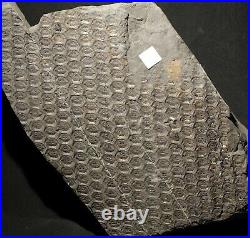

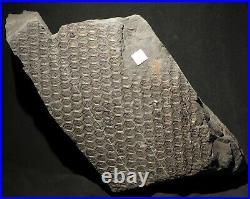



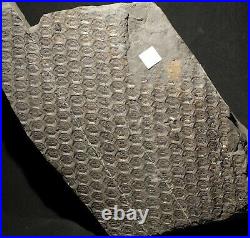

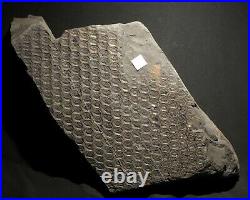

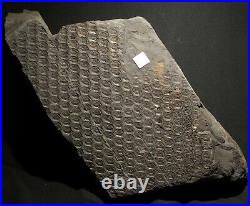

My specimens are genuine and will be delivered with a “Certificate of authenticity, age and origin” and scientific papers allowing plant identification!! I will send You a combine invoice. Rare, Classic coal age extinct lycopod – older Sigillaria species. All accurate data will be provided with the specimen. Upper Carboniferous – Middle Pennsylvanian / Namurian B – Siodlowe Beds. 14,0 x 10,0 x 3,0 cm (white square on pictures is 1,0 x 1,0 cm). Nice, big specimen of rarer older Sigillaria species – Classic coal age extinct lycopod. Is a genus of extinct, spore-bearing, arborescent (tree-like) plants which flourished in the Late Carboniferous period but dwindled to extinction in the early Permian period. It was a lycopodiophyte, and is related to the lycopsids, or club-mosses, but even more closely to quillworts, as was its associate Lepidodendron. Sigillaria was a tree-like plant, with a tall, occasionally forked trunk that lacked wood. Support came from a layer of closely packed leaf bases just below the surface of the trunk, while the center was filled with pith. The old leaf bases expanded as the trunk grew in width, and left a diamond-shaped pattern, which is evident in fossils. The trunk had photosynthetic tissue on the surface, meaning that it was probably green. The trunk was topped with a plume of long, grass-like, microphyllous leaves, so that the plant looked somewhat like a tall, forked bottlebrush. The plant bore its spores (not seeds) in cone-like structures attached to the stem. Sigillaria, like many ancient lycopods, had a relatively short life cycle – growing rapidly and reaching maturity in a few years. Some have suggested that Sigillaria was monocarpic, meaning that it died after reproduction, though this is not proven. It was associated with Lepidodendron, the scale tree, in the Carboniferous coal swamps. The clubmoss trees of the genus Sigillaria formed an important part of the coal swamps in the Late Carboniferous. They could reach a height up to 30 ms and bore grasslike leaves in the upper part of the unbranched or once divided trunk. The leaves were attached directly to the stem and they left scars when they were shed. Characteristic of the genus of Sigillaria is the fact that the leaf scars were arranged in vertical rows. On the ground of these leaf scars many species have been described. The trunk was somewhat thickened at the base. The spore-cones were attached in or under the crown directly to the stem. They are called Sigillariostrobus. The underground parts of the tree can hardly be distinguished from those of Lepidodendron and they are called Stigmaria. From the Westfalian D on the number of species of Sigillaria. The item “Pre dinosaur fossil plant big classic coal age lycopod rare Sigillaria elegans” is in sale since Sunday, September 6, 2020. This item is in the category “Collectables\Rocks, Fossils & Minerals\Fossils\Plants”. The seller is “paleobotanica_com” and is located in SOSNOWIEC. This item can be shipped to North, South, or Latin America, all countries in Europe, all countries in continental Asia.
- Pre dinosaur fossil plant: Carboniferous
- Modified Item: No
- Type: Fossils
- Sub-Type: Plants
